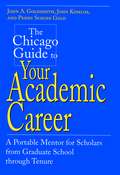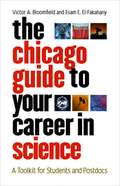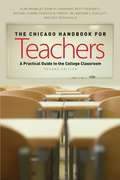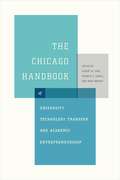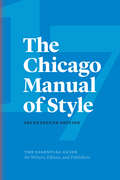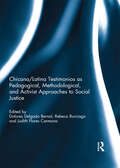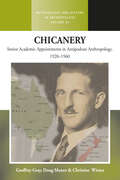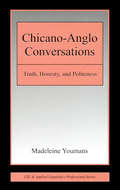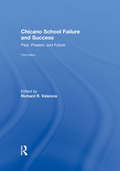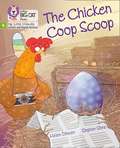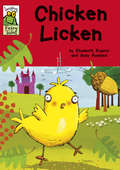- Table View
- List View
The Chicago Guide to Your Academic Career: A Portable Mentor for Scholars from Graduate School through Tenure (Chicago Guides to Academic Life)
by John A. Goldsmith John Komlos Penny Schine GoldIs a career as a professor the right choice for you? If you are a graduate student, how can you clear the hurdles successfully and position yourself for academic employment? What's the best way to prepare for a job interview, and how can you maximize your chances of landing a job that suits you? What happens if you don't receive an offer? How does the tenure process work, and how do faculty members cope with the multiple and conflicting day-to-day demands? With a perpetually tight job market in the traditional academic fields, the road to an academic career for many aspiring scholars will often be a rocky and frustrating one. Where can they turn for good, frank answers to their questions? Here, three distinguished scholars—with more than 75 years of combined experience—talk openly about what's good and what's not so good about academia, as a place to work and a way of life. Written as an informal conversation among colleagues, the book is packed with inside information—about finding a mentor, avoiding pitfalls when writing a dissertation, negotiating the job listings, and much more. The three authors' distinctive opinions and strategies offer the reader multiple perspectives on typical problems. With rare candor and insight, they talk about such tough issues as departmental politics, dual-career marriages, and sexual harassment. Rounding out the discussion are short essays that offer the "inside track" on financing graduate education, publishing the first book, and leaving academia for the corporate world. This helpful guide is for anyone who has ever wondered what the fascinating and challenging world of academia might hold in store. Part I - Becoming a Scholar * Deciding on an Academic Career * Entering Graduate School * The Mentor * Writing a Dissertation * Landing an Academic Job Part II - The Academic Profession * The Life of the Assistant Professor * Teaching and Research * Tenure * Competition in the University System and Outside Offers * The Personal Side of Academic Life
The Chicago Guide to Your Career in Science: A Toolkit for Students and Postdocs (Chicago Guides to Academic Life)
by Victor A. Bloomfield Esam E. El-FakahanyEmbarking upon research as a graduate student or postdoc can be exciting and enriching—the start of a rewarding career. But the world of scientific research is also a competitive one, with grants and good jobs increasingly hard to find. The Chicago Guide to Your Career in Science is intended to help scientists not just cope but excel at this critical phase in their careers. Victor A. Bloomfield and Esam E. El-Fakahany, both well-known scientists with extensive experience as teachers, mentors, and administrators, have combined their knowledge to create a guidebook that addresses all of the challenges that today’s scientists-in-training face. They begin by considering the early stages of a career in science: deciding whether or not to pursue a PhD, choosing advisors and mentors, and learning how to teach effectively. Bloomfield and El-Fakahany then explore the skills essential to conducting and presenting research. The Chicago Guide to Your Career in Science offers detailed advice on how to pursue research ethically, manage time, and communicate effectively, especially at academic conferences and with students and peers. Bloomfield and El-Fakahany write in accessible, straightforward language and include a synopsis of key points at the end of each chapter, so that readers can dip into relevant sections with ease. From students prepping for the GRE to postdocs developing professional contacts to faculty advisors and managers of corporate labs, scientists at every level will find The Chicago Guide to Your Career in Science an unparalleled resource. “The Chicago Guide to Your Career in Science is a roadmap to the beginning stages of a scientific career. I will encourage my own students to purchase it.”—Dov F. Sax, assistant professor of ecology and evolutionary biology, Brown University “Step-by-step, Victor Bloomfield and Esam El-Fakahany provide sound, thorough, yet succinct advice on every issue a scientist in training is likely to encounter. Young readers will welcome the authors’ advice on choosing a graduate school, for example, while senior scientists will probably wish that a book like this had been around when they were starting out. With down-to-earth and occasionally humorous advice, The Chicago Guide to your Career in Academic Biology belongs on the bookshelf of every graduate student and advisor.”—Norma Allewell, Dean, College of Chemical and Life Sciences, University of Maryland
The Chicago Guide to Your Career in Science: A Toolkit for Students and Postdocs (Chicago Guides to Academic Life)
by Victor A. Bloomfield Esam E. El-FakahanyEmbarking upon research as a graduate student or postdoc can be exciting and enriching—the start of a rewarding career. But the world of scientific research is also a competitive one, with grants and good jobs increasingly hard to find. The Chicago Guide to Your Career in Science is intended to help scientists not just cope but excel at this critical phase in their careers. Victor A. Bloomfield and Esam E. El-Fakahany, both well-known scientists with extensive experience as teachers, mentors, and administrators, have combined their knowledge to create a guidebook that addresses all of the challenges that today’s scientists-in-training face. They begin by considering the early stages of a career in science: deciding whether or not to pursue a PhD, choosing advisors and mentors, and learning how to teach effectively. Bloomfield and El-Fakahany then explore the skills essential to conducting and presenting research. The Chicago Guide to Your Career in Science offers detailed advice on how to pursue research ethically, manage time, and communicate effectively, especially at academic conferences and with students and peers. Bloomfield and El-Fakahany write in accessible, straightforward language and include a synopsis of key points at the end of each chapter, so that readers can dip into relevant sections with ease. From students prepping for the GRE to postdocs developing professional contacts to faculty advisors and managers of corporate labs, scientists at every level will find The Chicago Guide to Your Career in Science an unparalleled resource. “The Chicago Guide to Your Career in Science is a roadmap to the beginning stages of a scientific career. I will encourage my own students to purchase it.”—Dov F. Sax, assistant professor of ecology and evolutionary biology, Brown University “Step-by-step, Victor Bloomfield and Esam El-Fakahany provide sound, thorough, yet succinct advice on every issue a scientist in training is likely to encounter. Young readers will welcome the authors’ advice on choosing a graduate school, for example, while senior scientists will probably wish that a book like this had been around when they were starting out. With down-to-earth and occasionally humorous advice, The Chicago Guide to your Career in Academic Biology belongs on the bookshelf of every graduate student and advisor.”—Norma Allewell, Dean, College of Chemical and Life Sciences, University of Maryland
The Chicago Guide to Your Career in Science: A Toolkit for Students and Postdocs (Chicago Guides to Academic Life)
by Victor A. Bloomfield Esam E. El-FakahanyEmbarking upon research as a graduate student or postdoc can be exciting and enriching—the start of a rewarding career. But the world of scientific research is also a competitive one, with grants and good jobs increasingly hard to find. The Chicago Guide to Your Career in Science is intended to help scientists not just cope but excel at this critical phase in their careers. Victor A. Bloomfield and Esam E. El-Fakahany, both well-known scientists with extensive experience as teachers, mentors, and administrators, have combined their knowledge to create a guidebook that addresses all of the challenges that today’s scientists-in-training face. They begin by considering the early stages of a career in science: deciding whether or not to pursue a PhD, choosing advisors and mentors, and learning how to teach effectively. Bloomfield and El-Fakahany then explore the skills essential to conducting and presenting research. The Chicago Guide to Your Career in Science offers detailed advice on how to pursue research ethically, manage time, and communicate effectively, especially at academic conferences and with students and peers. Bloomfield and El-Fakahany write in accessible, straightforward language and include a synopsis of key points at the end of each chapter, so that readers can dip into relevant sections with ease. From students prepping for the GRE to postdocs developing professional contacts to faculty advisors and managers of corporate labs, scientists at every level will find The Chicago Guide to Your Career in Science an unparalleled resource. “The Chicago Guide to Your Career in Science is a roadmap to the beginning stages of a scientific career. I will encourage my own students to purchase it.”—Dov F. Sax, assistant professor of ecology and evolutionary biology, Brown University “Step-by-step, Victor Bloomfield and Esam El-Fakahany provide sound, thorough, yet succinct advice on every issue a scientist in training is likely to encounter. Young readers will welcome the authors’ advice on choosing a graduate school, for example, while senior scientists will probably wish that a book like this had been around when they were starting out. With down-to-earth and occasionally humorous advice, The Chicago Guide to your Career in Academic Biology belongs on the bookshelf of every graduate student and advisor.”—Norma Allewell, Dean, College of Chemical and Life Sciences, University of Maryland
The Chicago Handbook for Teachers, Second Edition: A Practical Guide to the College Classroom (Chicago Guides to Academic Life)
by Alan Brinkley Esam E. El-Fakahany Betty Dessants Michael Flamm Charles B. Forcey, Jr. Mathew L. Ouellett Eric RothschildThose who teach college students have extensive training in their disciplines, but unlike their counterparts at the high school or elementary school level, they often have surprisingly little instruction in the craft of teaching itself. The Chicago Handbook for Teachers, Second Edition, is an extraordinarily helpful guide for anyone facing the daunting challenge of putting together a course and delivering it successfully. Representing teachers at all stages of their careers, the authors, including distinguished historian Alan Brinkley, offer practical advice for almost any situation a new teacher might face, from preparing a syllabus to managing classroom dynamics. Beginning with a nuts and bolts plan for designing a course, the handbook also explains how to lead a discussion, evaluate your own teaching, give an effective lecture, supervise students' writing and research, create and grade exams, and more. This new edition is thoroughly revised for contemporary concerns, with updated coverage on the use of electronic resources and on the challenge of creating and sustaining an inclusive classroom. A new chapter on science education and new coverage of the distinctive issues faced by adjunct faculty broaden the book’s audience considerably. The addition of sample teaching materials in the appendixes enhances the practical, hands-on focus of the second edition. Its broad scope and wealth of specific tips will make The Chicago Handbook for Teachers useful both as a comprehensive guide for beginning educators and a reference manual for experienced instructors.
The Chicago Handbook for Teachers, Second Edition: A Practical Guide to the College Classroom (Chicago Guides to Academic Life)
by Alan Brinkley Esam E. El-Fakahany Betty Dessants Michael Flamm Charles B. Forcey, Jr. Mathew L. Ouellett Eric RothschildThose who teach college students have extensive training in their disciplines, but unlike their counterparts at the high school or elementary school level, they often have surprisingly little instruction in the craft of teaching itself. The Chicago Handbook for Teachers, Second Edition, is an extraordinarily helpful guide for anyone facing the daunting challenge of putting together a course and delivering it successfully. Representing teachers at all stages of their careers, the authors, including distinguished historian Alan Brinkley, offer practical advice for almost any situation a new teacher might face, from preparing a syllabus to managing classroom dynamics. Beginning with a nuts and bolts plan for designing a course, the handbook also explains how to lead a discussion, evaluate your own teaching, give an effective lecture, supervise students' writing and research, create and grade exams, and more. This new edition is thoroughly revised for contemporary concerns, with updated coverage on the use of electronic resources and on the challenge of creating and sustaining an inclusive classroom. A new chapter on science education and new coverage of the distinctive issues faced by adjunct faculty broaden the book’s audience considerably. The addition of sample teaching materials in the appendixes enhances the practical, hands-on focus of the second edition. Its broad scope and wealth of specific tips will make The Chicago Handbook for Teachers useful both as a comprehensive guide for beginning educators and a reference manual for experienced instructors.
The Chicago Handbook for Teachers, Second Edition: A Practical Guide to the College Classroom (Chicago Guides to Academic Life)
by Alan Brinkley Esam E. El-Fakahany Betty Dessants Michael Flamm Charles B. Forcey, Jr. Mathew L. Ouellett Eric RothschildThose who teach college students have extensive training in their disciplines, but unlike their counterparts at the high school or elementary school level, they often have surprisingly little instruction in the craft of teaching itself. The Chicago Handbook for Teachers, Second Edition, is an extraordinarily helpful guide for anyone facing the daunting challenge of putting together a course and delivering it successfully. Representing teachers at all stages of their careers, the authors, including distinguished historian Alan Brinkley, offer practical advice for almost any situation a new teacher might face, from preparing a syllabus to managing classroom dynamics. Beginning with a nuts and bolts plan for designing a course, the handbook also explains how to lead a discussion, evaluate your own teaching, give an effective lecture, supervise students' writing and research, create and grade exams, and more. This new edition is thoroughly revised for contemporary concerns, with updated coverage on the use of electronic resources and on the challenge of creating and sustaining an inclusive classroom. A new chapter on science education and new coverage of the distinctive issues faced by adjunct faculty broaden the book’s audience considerably. The addition of sample teaching materials in the appendixes enhances the practical, hands-on focus of the second edition. Its broad scope and wealth of specific tips will make The Chicago Handbook for Teachers useful both as a comprehensive guide for beginning educators and a reference manual for experienced instructors.
The Chicago Handbook for Teachers, Second Edition: A Practical Guide to the College Classroom (Chicago Guides to Academic Life)
by Alan Brinkley Esam E. El-Fakahany Betty Dessants Michael Flamm Charles B. Forcey, Jr. Mathew L. Ouellett Eric RothschildThose who teach college students have extensive training in their disciplines, but unlike their counterparts at the high school or elementary school level, they often have surprisingly little instruction in the craft of teaching itself. The Chicago Handbook for Teachers, Second Edition, is an extraordinarily helpful guide for anyone facing the daunting challenge of putting together a course and delivering it successfully. Representing teachers at all stages of their careers, the authors, including distinguished historian Alan Brinkley, offer practical advice for almost any situation a new teacher might face, from preparing a syllabus to managing classroom dynamics. Beginning with a nuts and bolts plan for designing a course, the handbook also explains how to lead a discussion, evaluate your own teaching, give an effective lecture, supervise students' writing and research, create and grade exams, and more. This new edition is thoroughly revised for contemporary concerns, with updated coverage on the use of electronic resources and on the challenge of creating and sustaining an inclusive classroom. A new chapter on science education and new coverage of the distinctive issues faced by adjunct faculty broaden the book’s audience considerably. The addition of sample teaching materials in the appendixes enhances the practical, hands-on focus of the second edition. Its broad scope and wealth of specific tips will make The Chicago Handbook for Teachers useful both as a comprehensive guide for beginning educators and a reference manual for experienced instructors.
The Chicago Handbook for Teachers, Second Edition: A Practical Guide to the College Classroom (Chicago Guides to Academic Life)
by Alan Brinkley Esam E. El-Fakahany Betty Dessants Michael Flamm Charles B. Forcey, Jr. Mathew L. Ouellett Eric RothschildThose who teach college students have extensive training in their disciplines, but unlike their counterparts at the high school or elementary school level, they often have surprisingly little instruction in the craft of teaching itself. The Chicago Handbook for Teachers, Second Edition, is an extraordinarily helpful guide for anyone facing the daunting challenge of putting together a course and delivering it successfully. Representing teachers at all stages of their careers, the authors, including distinguished historian Alan Brinkley, offer practical advice for almost any situation a new teacher might face, from preparing a syllabus to managing classroom dynamics. Beginning with a nuts and bolts plan for designing a course, the handbook also explains how to lead a discussion, evaluate your own teaching, give an effective lecture, supervise students' writing and research, create and grade exams, and more. This new edition is thoroughly revised for contemporary concerns, with updated coverage on the use of electronic resources and on the challenge of creating and sustaining an inclusive classroom. A new chapter on science education and new coverage of the distinctive issues faced by adjunct faculty broaden the book’s audience considerably. The addition of sample teaching materials in the appendixes enhances the practical, hands-on focus of the second edition. Its broad scope and wealth of specific tips will make The Chicago Handbook for Teachers useful both as a comprehensive guide for beginning educators and a reference manual for experienced instructors.
The Chicago Handbook for Teachers, Second Edition: A Practical Guide to the College Classroom (Chicago Guides to Academic Life)
by Alan Brinkley Esam E. El-Fakahany Betty Dessants Michael Flamm Charles B. Forcey, Jr. Mathew L. Ouellett Eric RothschildThose who teach college students have extensive training in their disciplines, but unlike their counterparts at the high school or elementary school level, they often have surprisingly little instruction in the craft of teaching itself. The Chicago Handbook for Teachers, Second Edition, is an extraordinarily helpful guide for anyone facing the daunting challenge of putting together a course and delivering it successfully. Representing teachers at all stages of their careers, the authors, including distinguished historian Alan Brinkley, offer practical advice for almost any situation a new teacher might face, from preparing a syllabus to managing classroom dynamics. Beginning with a nuts and bolts plan for designing a course, the handbook also explains how to lead a discussion, evaluate your own teaching, give an effective lecture, supervise students' writing and research, create and grade exams, and more. This new edition is thoroughly revised for contemporary concerns, with updated coverage on the use of electronic resources and on the challenge of creating and sustaining an inclusive classroom. A new chapter on science education and new coverage of the distinctive issues faced by adjunct faculty broaden the book’s audience considerably. The addition of sample teaching materials in the appendixes enhances the practical, hands-on focus of the second edition. Its broad scope and wealth of specific tips will make The Chicago Handbook for Teachers useful both as a comprehensive guide for beginning educators and a reference manual for experienced instructors.
The Chicago Handbook of University Technology Transfer and Academic Entrepreneurship
by Albert N. Link, Donald S. Siegel, and Mike WrightAs state support and federal research funding dwindle, universities are increasingly viewing their intellectual property portfolios as lucrative sources of potential revenue. Nearly all research universities now have a technology transfer office to manage their intellectual property, but many are struggling to navigate this new world of university-industry partnerships. Given the substantial investment in academic research and millions of dollars potentially at stake, identifying best practices in university technology transfer and academic entrepreneurship is of paramount importance. The Chicago Handbook of University Technology Transfer and Academic Entrepreneurship is the first definitive source to synthesize state-of-the-art research in this arena. Edited by three of the foremost experts in the field, the handbook presents evidence from entrepreneurs, administrators, regulators, and professors in numerous disciplines. Together they address the key managerial and policy implications through chapters on how to sustain successful research ventures, ways to stimulate academic entrepreneurship, maintain effective open innovation strategies, and improve the performance of university technology transfer offices. A broad and ambitious work, the handbook offers comprehensive coverage for universities of all types, allowing them to confidently handle technology commercialization and further cultivate innovation.
The Chicago Handbook of University Technology Transfer and Academic Entrepreneurship
by Albert N. Link, Donald S. Siegel, and Mike WrightAs state support and federal research funding dwindle, universities are increasingly viewing their intellectual property portfolios as lucrative sources of potential revenue. Nearly all research universities now have a technology transfer office to manage their intellectual property, but many are struggling to navigate this new world of university-industry partnerships. Given the substantial investment in academic research and millions of dollars potentially at stake, identifying best practices in university technology transfer and academic entrepreneurship is of paramount importance. The Chicago Handbook of University Technology Transfer and Academic Entrepreneurship is the first definitive source to synthesize state-of-the-art research in this arena. Edited by three of the foremost experts in the field, the handbook presents evidence from entrepreneurs, administrators, regulators, and professors in numerous disciplines. Together they address the key managerial and policy implications through chapters on how to sustain successful research ventures, ways to stimulate academic entrepreneurship, maintain effective open innovation strategies, and improve the performance of university technology transfer offices. A broad and ambitious work, the handbook offers comprehensive coverage for universities of all types, allowing them to confidently handle technology commercialization and further cultivate innovation.
The Chicago Handbook of University Technology Transfer and Academic Entrepreneurship
by Albert N. Link Donald S. Siegel Mike WrightAs state support and federal research funding dwindle, universities are increasingly viewing their intellectual property portfolios as lucrative sources of potential revenue. Nearly all research universities now have a technology transfer office to manage their intellectual property, but many are struggling to navigate this new world of university-industry partnerships. Given the substantial investment in academic research and millions of dollars potentially at stake, identifying best practices in university technology transfer and academic entrepreneurship is of paramount importance. The Chicago Handbook of University Technology Transfer and Academic Entrepreneurship is the first definitive source to synthesize state-of-the-art research in this arena. Edited by three of the foremost experts in the field, the handbook presents evidence from entrepreneurs, administrators, regulators, and professors in numerous disciplines. Together they address the key managerial and policy implications through chapters on how to sustain successful research ventures, ways to stimulate academic entrepreneurship, maintain effective open innovation strategies, and improve the performance of university technology transfer offices. A broad and ambitious work, the handbook offers comprehensive coverage for universities of all types, allowing them to confidently handle technology commercialization and further cultivate innovation.
The Chicago Handbook of University Technology Transfer and Academic Entrepreneurship
by Albert N. Link Donald S. Siegel Mike WrightAs state support and federal research funding dwindle, universities are increasingly viewing their intellectual property portfolios as lucrative sources of potential revenue. Nearly all research universities now have a technology transfer office to manage their intellectual property, but many are struggling to navigate this new world of university-industry partnerships. Given the substantial investment in academic research and millions of dollars potentially at stake, identifying best practices in university technology transfer and academic entrepreneurship is of paramount importance. The Chicago Handbook of University Technology Transfer and Academic Entrepreneurship is the first definitive source to synthesize state-of-the-art research in this arena. Edited by three of the foremost experts in the field, the handbook presents evidence from entrepreneurs, administrators, regulators, and professors in numerous disciplines. Together they address the key managerial and policy implications through chapters on how to sustain successful research ventures, ways to stimulate academic entrepreneurship, maintain effective open innovation strategies, and improve the performance of university technology transfer offices. A broad and ambitious work, the handbook offers comprehensive coverage for universities of all types, allowing them to confidently handle technology commercialization and further cultivate innovation.
The Chicago Manual of Style, 17th Edition
by The University of Chicago Press Editorial StaffTechnologies may change, but the need for clear and accurate communication never goes out of style. That is why for more than one hundred years The Chicago Manual of Style has remained the definitive guide for anyone who works with words. In the seven years since the previous edition debuted, we have seen an extraordinary evolution in the way we create and share knowledge. This seventeenth edition of The Chicago Manual of Style has been prepared with an eye toward how we find, create, and cite information that readers are as likely to access from their pockets as from a bookshelf. It offers updated guidelines on electronic workflows and publication formats, tools for PDF annotation and citation management, web accessibility standards, and effective use of metadata, abstracts, and keywords. It recognizes the needs of those who are self-publishing or following open access or Creative Commons publishing models. The citation chapters reflect the ever-expanding universe of electronic sources—including social media posts and comments, private messages, and app content—and also offer updated guidelines on such issues as DOIs, time stamps, and e-book locators. Other improvements are independent of technological change. The chapter on grammar and usage includes an expanded glossary of problematic words and phrases and a new section on syntax as well as updated guidance on gender-neutral pronouns and bias-free language. Key sections on punctuation and basic citation style have been reorganized and clarified. To facilitate navigation, headings and paragraph titles have been revised and clarified throughout. And the bibliography has been updated and expanded to include the latest and best resources available. This edition continues to reflect expert insights gathered from Chicago’s own staff and from an advisory board of publishing experts from across the profession. It also includes suggestions inspired by emails, calls, and even tweets from readers. No matter how much the means of communication change, The Chicago Manual of Style remains the ultimate resource for those who care about getting the details right.
Chicana/Latina Testimonios as Pedagogical, Methodological, and Activist Approaches to Social Justice
by Dolores Delgado Bernal Rebeca Burciaga Judith Flores CarmonaWhile the genre of testimonio has deep roots in oral cultures and in Latin American human rights struggles, the publication and subsequent adoption of This Bridge Called My Back (Moraga & Anzaldúa, 1983) and, more recently, Telling to Live: Latina Feminist Testimonios (Latina Feminist Group, 2001), have demonstrated the power of testimonio as a genre that exposes brutality, disrupts silencing, and builds solidarity among women of colour. Within the field of education, scholars are increasingly taking up testimonio as a pedagogical, methodological, and activist approach to social justice, which transgresses traditional paradigms in academia. Unlike the more usual approach of researchers producing unbiased knowledge, the testimonio challenges objectivity by situating the individual in communion with a collective experience marked by marginalization, oppression, or resistance. This approach has resulted in new understandings about how marginalized communities build solidarity, and respond to and resist dominant culture, laws, and policies that perpetuate inequity. This book contributes to our understanding of testimonio as it relates to methodology, pedagogy, research, and reflection in pursuit of social justice. A common thread among the chapters is a sense of political urgency to address inequities within Chicana/o and Latina/o communities. This book was originally published as a special issue of Equity & Excellence in Education.
Chicana/Latina Testimonios as Pedagogical, Methodological, and Activist Approaches to Social Justice
by Dolores Delgado Bernal, Rebeca Burciaga and Judith Flores CarmonaWhile the genre of testimonio has deep roots in oral cultures and in Latin American human rights struggles, the publication and subsequent adoption of This Bridge Called My Back (Moraga & Anzaldúa, 1983) and, more recently, Telling to Live: Latina Feminist Testimonios (Latina Feminist Group, 2001), have demonstrated the power of testimonio as a genre that exposes brutality, disrupts silencing, and builds solidarity among women of colour. Within the field of education, scholars are increasingly taking up testimonio as a pedagogical, methodological, and activist approach to social justice, which transgresses traditional paradigms in academia. Unlike the more usual approach of researchers producing unbiased knowledge, the testimonio challenges objectivity by situating the individual in communion with a collective experience marked by marginalization, oppression, or resistance. This approach has resulted in new understandings about how marginalized communities build solidarity, and respond to and resist dominant culture, laws, and policies that perpetuate inequity. This book contributes to our understanding of testimonio as it relates to methodology, pedagogy, research, and reflection in pursuit of social justice. A common thread among the chapters is a sense of political urgency to address inequities within Chicana/o and Latina/o communities. This book was originally published as a special issue of Equity & Excellence in Education.
Chicanery: Senior Academic Appointments in Antipodean Anthropology, 1920–1960 (Methodology & History in Anthropology #44)
by Geoffrey Gray Doug Munro Christine WinterAcademic appointments can bring forth unexpected and unforeseen contests and tensions, cause humiliation and embarrassment for unsuccessful applicants and reveal unexpected allies and enemies. It is also a time when harsh assessments can be made about colleagues’ intellectual abilities and their capacity as a scholar and fieldworker. The assessors’ reports were often disturbingly personal, laying bare their likes and dislikes that could determine the futures of peers and colleagues. Chicanery deals with how the founding Chairs at Sydney, the Australian National University, Auckland and Western Australia dealt with this process, and includes accounts of the appointments of famous anthropologists such as Raymond Firth and Alexander Ratcliffe-Brown.
Chicanery: Senior Academic Appointments in Antipodean Anthropology, 1920–1960 (Methodology & History in Anthropology #44)
by Geoffrey Gray Doug Munro Christine WinterAcademic appointments can bring forth unexpected and unforeseen contests and tensions, cause humiliation and embarrassment for unsuccessful applicants and reveal unexpected allies and enemies. It is also a time when harsh assessments can be made about colleagues’ intellectual abilities and their capacity as a scholar and fieldworker. The assessors’ reports were often disturbingly personal, laying bare their likes and dislikes that could determine the futures of peers and colleagues. Chicanery deals with how the founding Chairs at Sydney, the Australian National University, Auckland and Western Australia dealt with this process, and includes accounts of the appointments of famous anthropologists such as Raymond Firth and Alexander Ratcliffe-Brown.
Chicano-Anglo Conversations: Truth, Honesty, and Politeness (ESL & Applied Linguistics Professional Series)
by Madeleine YoumansThis groundbreaking book--about differences in communication practices between Mexican-American underclass residents in an East Los Angeles housing project and white, middle-class literacy tutors who worked with them--makes an important contribution to research on the sociolinguistics of the Chicano gang culture. More specifically, this work adds substantially to research on understanding linguistic politeness theories, the use of epistemic modals for negative politeness, and evidentiality. It refines, and in a number of cases, defines, function categories for epistemic modals through a rigorous grammatical analysis. This book is also distinctive in that the author subjects the language of middle-class Anglos to the same type of scrutiny that is often reserved for non-mainstream groups. Youmans contends that the differences between the Chicano and Anglo speakers are the result of the two groups’ different sociocultural circumstances, including historical and current living and working patterns and the relative value placed on familialism and communalism versus individualism and independence. (The terms Chicano and Anglo are used as a kind of shorthand in this book--not to raise larger sociocultural issues implied by these terms.) Although the number of participants in the study limits the applicability of the findings as they might be extrapolated to all Chicanos/as, or all Anglos when reporting sociolinguistic observations, the main argument advanced is that language use may provide insights into beliefs, attitudes, and practices in the larger society. This volume is directed to researchers and graduate students in the areas of sociolinguistics, applied linguistics, discourse analysis, and cross-cultural communication, and will also interest language and linguistics educators and grammarians.
Chicano-Anglo Conversations: Truth, Honesty, and Politeness (ESL & Applied Linguistics Professional Series)
by Madeleine YoumansThis groundbreaking book--about differences in communication practices between Mexican-American underclass residents in an East Los Angeles housing project and white, middle-class literacy tutors who worked with them--makes an important contribution to research on the sociolinguistics of the Chicano gang culture. More specifically, this work adds substantially to research on understanding linguistic politeness theories, the use of epistemic modals for negative politeness, and evidentiality. It refines, and in a number of cases, defines, function categories for epistemic modals through a rigorous grammatical analysis. This book is also distinctive in that the author subjects the language of middle-class Anglos to the same type of scrutiny that is often reserved for non-mainstream groups. Youmans contends that the differences between the Chicano and Anglo speakers are the result of the two groups’ different sociocultural circumstances, including historical and current living and working patterns and the relative value placed on familialism and communalism versus individualism and independence. (The terms Chicano and Anglo are used as a kind of shorthand in this book--not to raise larger sociocultural issues implied by these terms.) Although the number of participants in the study limits the applicability of the findings as they might be extrapolated to all Chicanos/as, or all Anglos when reporting sociolinguistic observations, the main argument advanced is that language use may provide insights into beliefs, attitudes, and practices in the larger society. This volume is directed to researchers and graduate students in the areas of sociolinguistics, applied linguistics, discourse analysis, and cross-cultural communication, and will also interest language and linguistics educators and grammarians.
Chicano School Failure and Success: Past, Present, and Future
by Richard R. ValenciaThe third edition of the best selling collection, Chicano School Failure and Success presents a complete and comprehensive review of the multiple and complex issues affecting Chicano students today. Richly informative and accessibly written, this edition includes completely revised and updated chapters that incorporate recent scholarship and research on the current realities of the Chicano school experience. It features four entirely new chapters on important topics such as la Chicana, two way dual language education, higher education, and gifted Chicano students. Contributors to this edition include experts in fields ranging from higher education, bilingual education, special education, gifted education, educational psychology, and anthropology. In order to capture the broad nature of Chicano school failure and success, contributors provide an in-depth look at topics as diverse as Chicano student dropout rates, the relationship between Chicano families and schools, and the impact of standards-based school reform and deficit thinking on Chicano student achievement. Committed to understanding the plight and improvement of schooling for Chicanos, this timely new edition addresses all the latest issues in Chicano education and will be a valued resource for students, educators, researchers, policy makers, and community activists alike.
Chicano School Failure and Success: Past, Present, and Future
by Richard R. ValenciaThe third edition of the best selling collection, Chicano School Failure and Success presents a complete and comprehensive review of the multiple and complex issues affecting Chicano students today. Richly informative and accessibly written, this edition includes completely revised and updated chapters that incorporate recent scholarship and research on the current realities of the Chicano school experience. It features four entirely new chapters on important topics such as la Chicana, two way dual language education, higher education, and gifted Chicano students. Contributors to this edition include experts in fields ranging from higher education, bilingual education, special education, gifted education, educational psychology, and anthropology. In order to capture the broad nature of Chicano school failure and success, contributors provide an in-depth look at topics as diverse as Chicano student dropout rates, the relationship between Chicano families and schools, and the impact of standards-based school reform and deficit thinking on Chicano student achievement. Committed to understanding the plight and improvement of schooling for Chicanos, this timely new edition addresses all the latest issues in Chicano education and will be a valued resource for students, educators, researchers, policy makers, and community activists alike.
Chicken Licken (Leapfrog Fairy Tales)
by Elizabeth RogersWhen an acorn falls on the head of a silly young chick, she decides the sky is falling in and rushes off to tell the king. A classic tale with lots of repetition to support new readers.The Leapfrog Fairy Tales series features some of our best-loved fairy tales, simply retold in under 180 words, with bright illustrations for children to read on their own.
